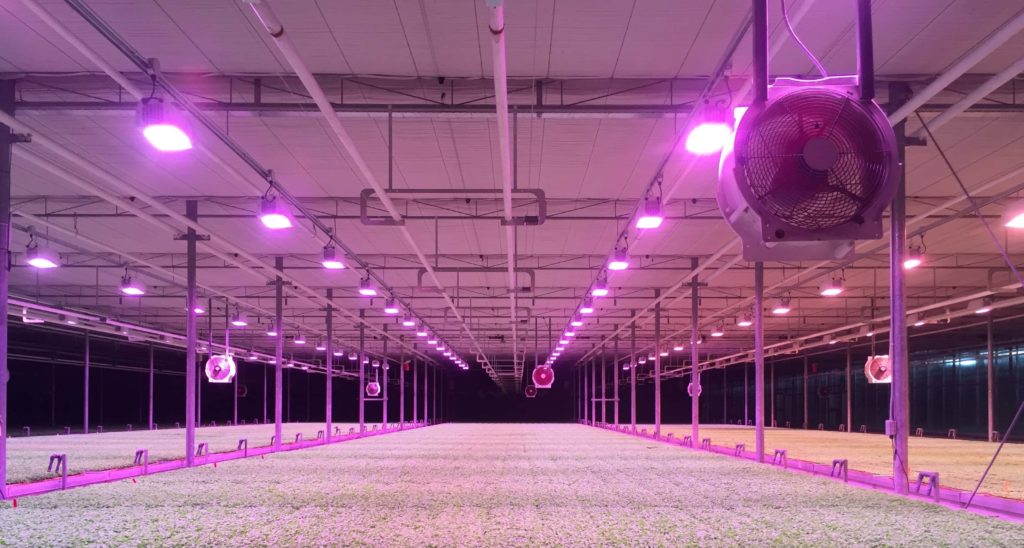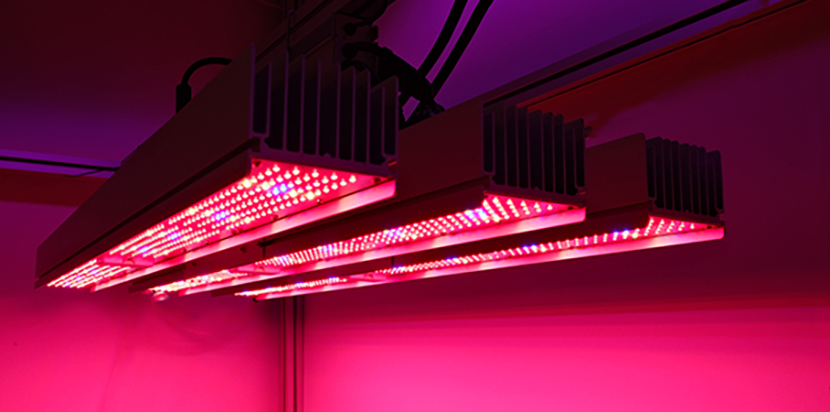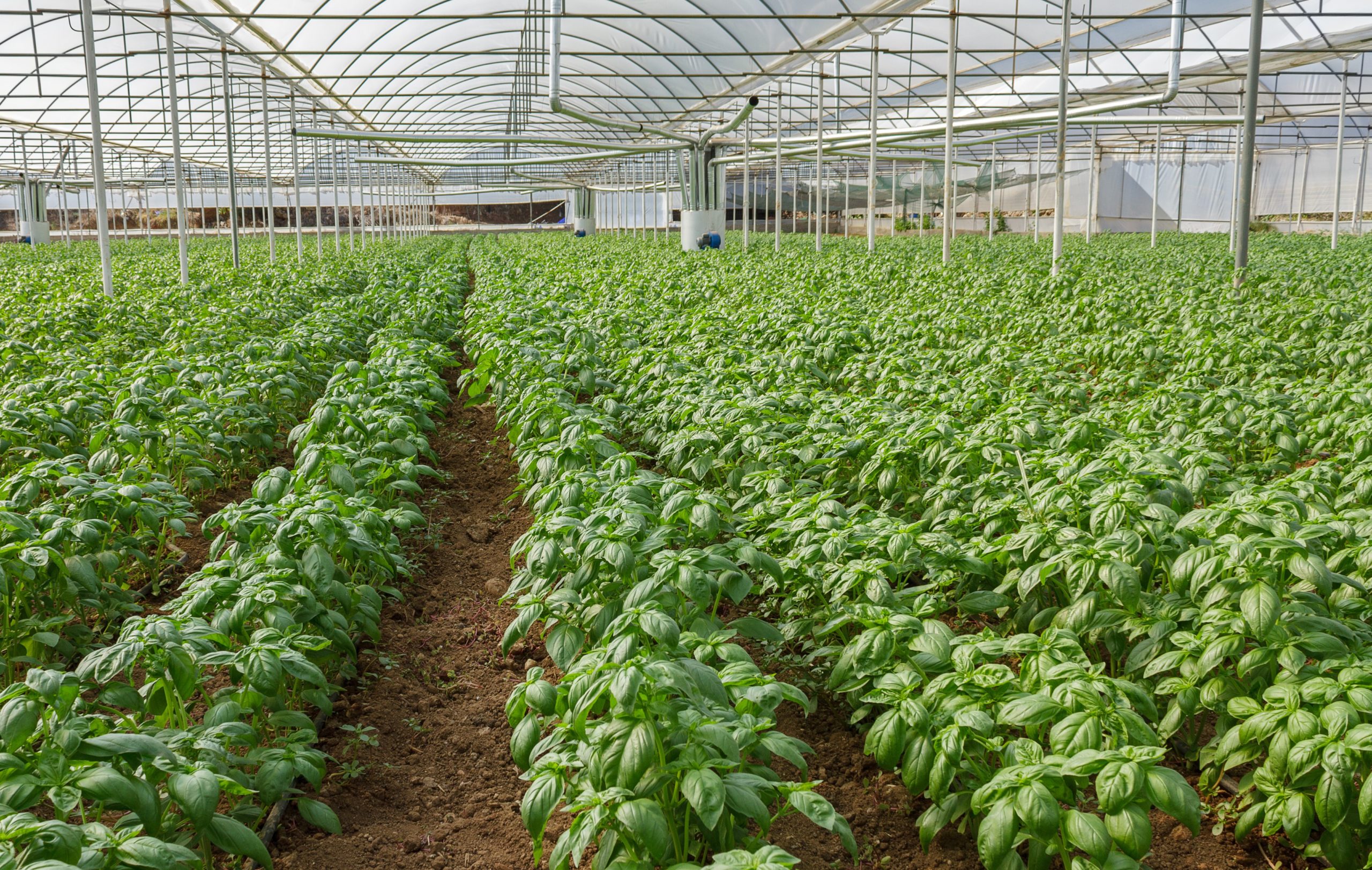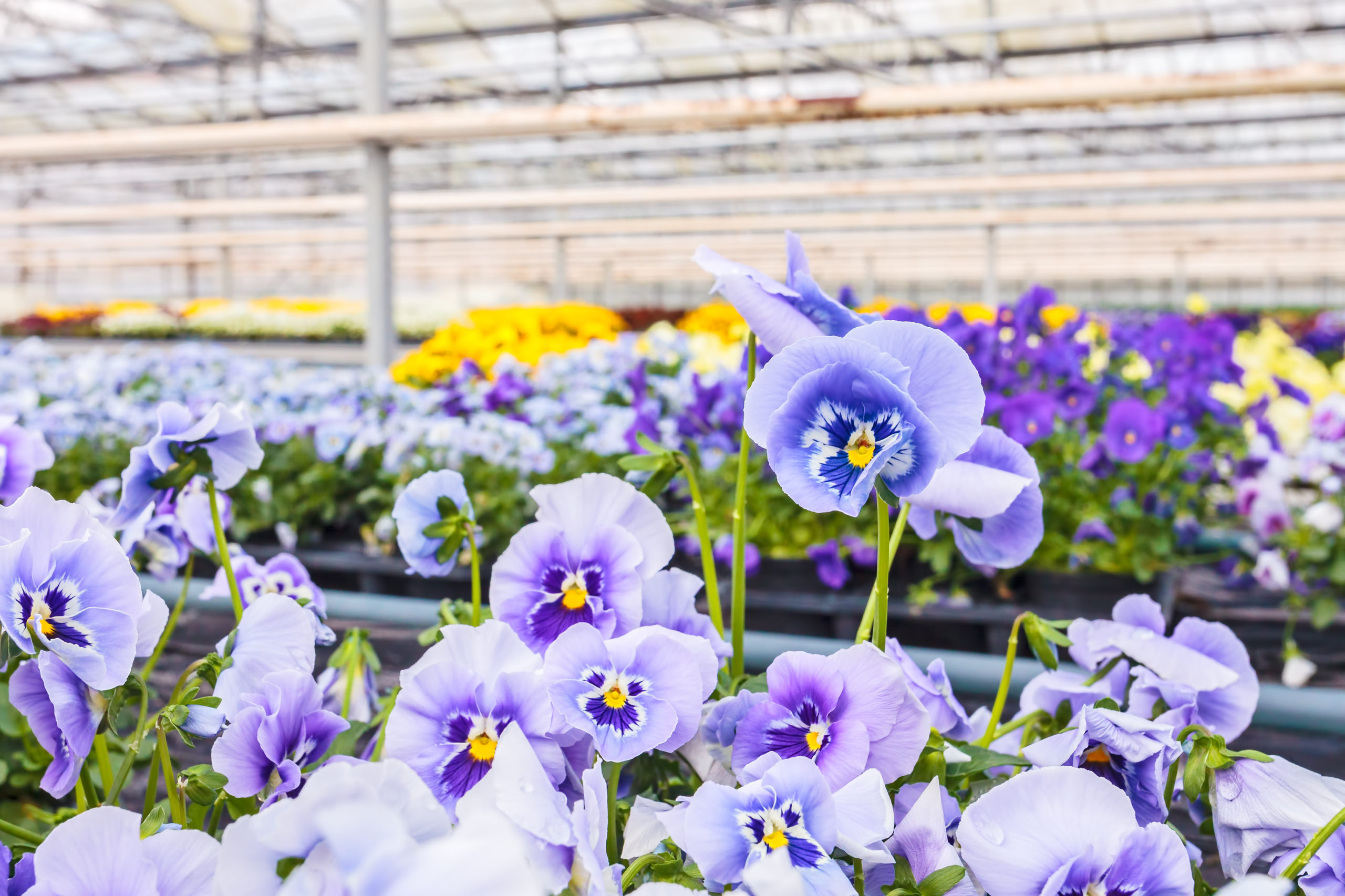Food
Research
In recent years, there has been increasing interest in plant production in indoor facilities. These facilities include greenhouses and vertical farms.
The major advantages these facilities present are protection from unfavourable weather conditions, increased pest protection and a control over resources usage. To ensure year-round, high-quality crop production, LED grow lights must be used. This requires the correct choice of spectrum, intensity, and duration of illumination.
Longer days enhances vegetative growth
The time plants are exposed to light, or, more precisely the ratio of light and darkness in 24 hours, is called photoperiod. The common metric used to measure light for plants is Daily Light Integral (DLI). DLI is the sum of all momentous light intensities over 24 hours. Generally, the more photons, i.e. higher DLI plants receive, the better they grow and produce higher yield. However, each species has an optimal light intensity over which value the light absorption and photosynthesis is not as efficient as below it. Therefore, for optimal vegetative growth it is usually better to provide lower light intensities over a longer photoperiod. On the other hand, light hungry crops will benefit from the additional light of the day extension even in climatic zones with naturally high light intensities. For example, optimal photoperiod is reported to be 14 to18 hours for tomato and 22 hours for sweet pepper (Demers and Gosselin, 2002, Paucek et al, 2020, Velez-Ramirez et al, 2014).
During the night plants burn sugars they produce in the daylight
In a process of photosynthesis, plants convert absorbed photons, assimilated CO2 and water to sugars, which they accumulate. Sugars can subsequently be used to build plant structure and biomass or power life processes including growth, flowering, the transport of nutrients, biosynthesis of other biochemicals, and protection from diseases. Plants, like animals, “breathe” and burn accumulated sugars using O2 to produce energy they need. We call the breathing of plants respiration. Plants respire continuously. At night when there is no energy from light, plants depend only on accumulated sugars.
In a short photoperiod, when the day is short and the night is long, plants tend to spare sugars, e.g. by limiting they growth, in order to have enough energy to survive until morning (Gent 2018). Night respiration is enhanced in higher temperatures and elevated CO2. Many plants grow better and produce higher quality crops when the same amount of light, i.e., the same DLI, is provided over a longer photoperiod.
Do plants need night at all?
Plants do not sleep the same way as animals. Many plants require a dark period for proper growth and development. Plants have a biochemical mechanism known as a “circadian clock” that initiates and synchronizes life processes, including germination, growth, and flowering. Regular occurrence of a dark period regulates the plant’s internal clock. Yet many species can grow normally in a very short night.
Speed breeding techniques adopt photoperiods of 22 to 23 hours of light, high light intensity and controlled temperature to accelerate development and seed production of species such as wheat, barley, chickpea, pea, canola, clover and peanuts (Watson et al, 2018). Providing plants with high light intensity over a long photoperiod is expensive, so the application of speed breeding is limited to production of new varieties of commercially important crops.
However, extension of the photoperiod shortens time to harvest of many crops and should be considered in every situation when species tolerance of long photoperiods, growing conditions and electricity prices justify the investment.
Some plants need specific length of darkness to flower
Cultivation of some plant species requires careful control of photoperiod, as many plants are sensitive to relative length of day and night. There are species, varieties and cultivars, which require a darkness period longer than a critical time to set buds or to develop properly build flowers. Short-day plants include chrysanthemum, poinsettia, rice, cotton, a few strawberry varieties, and . Some short-day plants, called obligative or quantitative short-day plants, are very sensitive, and they require total, uninterrupted darkness over many hours to flower. Others, called quantitative short-day plants, can set flowers even if night is slightly shorter than typical requirements, but flowering may be delayed or not maximal. In the case of short-day plants, supplemental LED lighting is useful to prevent premature or unsynchronized flowering and assures that plants grow strong in a vegetative stage and accumulate enough sugars (energy) to support bountiful flowering.
Long-day plants, on the other hand, require nights that are shorter to flower. Examples of long-day plants are lettuce, spinach, petunia, wheat and arabidopsis. If accelerated flowering is not desired (e.g. in leafy greens production), the length of photoperiod should be adjusted, and very long photoperiods are not recommended.
For example, lettuce usually shows a reverse linear relationship between photoperiod length and the time to flowering (Waycott 1995). Lettuce also shows large genetic variations in flowering time. Early flowering varieties grown under longer photoperiod (exceeding 14 to16h) can bolt before achieving market maturity. The effect of photoperiod is accelerated in higher temperatures. Other cultivars can be successfully grown under 20 h photoperiod (Waycott 1995) or even under continuous light (i.e. under 24h photoperiod) with healthy morphology and without any injury symptoms (Zha et al, 2019). Hence, the optimal photoperiod for lettuce should be individually adjusted based on genetic predisposition and growing conditions.
Some species are day-neutral, meaning their flowering isn’t dependent on light and darkness. These plants produce flowers when they reach a specific life stage, such as a certain age or a certain number of leaves. Although day neutral plants flower regardless of day length, their flowering and fruiting are stronger with a long photoperiod. Some cultivars may be day-neutral, even if other cultivars or varieties from the same species are photoperiod sensitive.
Light of different colours can be used to regulate flowering of plants sensitive to day length
Long and short-day plants are often sensitive to spectral composition (colour) of light. Red, far‐red, blue and green light all regulate flowering through different photoreceptors (phytochromes and cryptochromes). Short-day plants are sensitive to far-red (FR) and a low red to FR ratio can stimulate flowering. Some of the long-day plants also respond to increased amounts of FR light in a growth spectrum. While FR light may not stimulate bud set directly, it does improve efficiency of light interception or incoming sunlight. To achieve best results, a FR enriched spectrum is recommended to be used during the seedling and young plant stage (Park and Runkle 2017).
A lack of FR in a growth spectrum can supress flower initiation or development in some species (Runkle and Heins 2001). Scientists have experimented with using various light wavelengths to stimulate flowering in short-day plants during long photoperiods. This approach can help short-day plants bloom when the day is extended. As mentioned, during long photoperiod plants can be exposed to a higher DLI to assimilate more photons, and thus develop faster and grow stronger.
However, short-day plants cannot set flowers when the day is too long. Short day chrysanthemums flowered in long-day conditions when the day was extended with low levels of monochromatic blue light (Park and Runkle 2019). Monochromatic light is not optimal for plant growth. However, when it is used only for a fraction of a day to provide much needed photons without seriously disturbing plant morphology, the blue light day extension proved not to inhibit flower initiation in this case of chrysanthemums. This experiment illustrates the possibilities offered by intelligent, controllable LED grow lights. LED lighting solutions offer also the ability to customize and adjust the red to far-red ratio to the needs of specific cultivars or production goals.
Tools to control DLI and photoperiod
One of the advantages of LED grow lights over traditional greenhouse lighting (e.g. HPS bulbs) is the possibility to regulate light output intensity as well as switching LEDs of and on without reducing their efficacy and longevity. Effective controls can adjust supplemental light levels to meet plants’ precise requirements. This ensures optimal growth conditions.
Connecting greenhouse lights to an automated light control system such as helioCORE™ expands the natural photoperiod and monitors the amount of light plants are exposed to in real-time and over the course of the full day. With the help of predictive algorithms, a grower can also cost-effectively ensure that crops receive the desired DLI over a planned photoperiod. With dynamic light control technology, the supplemental LED lights are used only when needed, providing stable light conditions to optimize crop growth and consistent production. HelioCORE™ enables growers to create their own individual lighting strategies and treatments with flexible, adjustable spectrum to meet specific crop requirements and cultivation goals.
References
Demers, D. A., Gosselin, A. (2002).Growing greenhouse tomato and sweet pepper under supplemental lighting: optimal photoperiod, negative effects of of long photoperiod and their causes. Acta Horticulturae, 580, 83–88. https://doi.org/10.17660/ActaHortic.2002.580.9
Gent, M. P. N. (2018). Dynamic carbohydrate supply and demand model of vegetative growth : response to temperature, light, carbon dioxide, and day length. Agronomy, 8, 21. https://doi.org/10.3390/agronomy8020021
Paucek, I., Pennisi, G., Pistillo, A., & Appolloni, E. (2020). Supplementary LED Interlighting Improves Yield and Precocity of Greenhouse Tomatoes in the Mediterranean. Agronomy, 10(July). https://doi.org/10.3390/agronomy10071002
Park, Y., & Runkle, E. S. (2017). Far-red radiation promotes growth of seedlings by increasing leaf expansion and whole-plant net assimilation. Environmental and Experimental Botany, 136. https://doi.org/10.1016/j.envexpbot.2016.12.013
Park, Y., & Runkle, E. S. (2018). Spectral effects of light-emitting diodes on plant growth, visual color quality, and photosynthetic photon efficacy: White versus blue plus red radiation. PLoS ONE, 13(8), 1–14. https://doi.org/10.1371/journal.pone.0202386
Runkle, E. S., & Heins, R. D. (2001). Specific functions of red, far red, and blue light in flowering and stem extension of long-day plants. Journal of the American Society for Horticultural Science, 126(3), 275–282. https://doi.org/10.21273/jashs.126.3.275
Velez-Ramirez, A. I., van Ieperen, W., Vreugdenhil, D., van Poppel, P. M. J. A., Heuvelink, E., & Millenaar, F. F. (2014). A single locus confers tolerance to continuous light and allows substantial yield increase in tomato. Nature Communications, 5(1), 4549. https://doi.org/10.1038/ncomms5549
Watson, A., Ghosh, S., Williams, M. J., Cuddy, W. S., Simmonds, J., Rey, M. D., Asyraf Md Hatta, M., Hinchliffe, A., Steed, A., Reynolds, D., Adamski, N. M., Breakspear, A., Korolev, A., Rayner, T., Dixon, L. E., Riaz, A., Martin, W., Ryan, M., Edwards, D., … Hickey, L. T. (2018). Speed breeding is a powerful tool to accelerate crop research and breeding. Nature Plants, 4(1), 23–29. https://doi.org/10.1038/s41477-017-0083-8
Waycott, W. (1995). Photoperiodic response of genetically diverse lettuce accessions. Journal of the American Society for Horticultural Science, 120(3), 460–467. https://doi.org/10.21273/jashs.120.3.460
Zha, L., Liu, W., Zhang, Y., Zhou, C., & Shao, M. (2019). Morphological and Physiological Stress Responses of Lettuce to Different Intensities of Continuous Light . In Frontiers in Plant Science (Vol. 10, p. 1440). https://www.frontiersin.org/article/10.3389/fpls.2019.01440
Get in touch with us!
From custom light planning, to tailored quotes, and everything in between,
our team of horticulture experts are always ready to assist.






